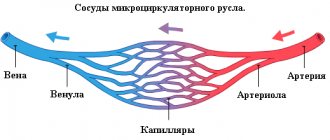Causes of atonic constipation
The causes of atonic constipation include the following factors:
- abnormalities of intestinal development;
- diseases of the endocrine system, changes in hormone levels (during pregnancy, menopause, etc.);
- neurological disorders;
- spinal cord injuries;
- taking medications that affect intestinal motility.
The cause of atonic constipation is a sedentary lifestyle. It is not necessary to have a sedentary job - atonic constipation also occurs after injuries and operations, when it is necessary to adhere to bed rest. Other possible causes include intoxication, exacerbation of inflammatory diseases, depression, bad habits, and infectious diseases.
A number of medications change muscle tone; antispasmodics, analgesics, antidepressants, some hormonal drugs, and medications that affect the transmission of nerve impulses can weaken it.
So-called idiopathic constipation has no known cause. Atonic constipation is often idiopathic in nature.
It is believed that intestinal dyskinesia is characteristic of functional constipation and irritable bowel syndrome with their predominance. But the slow movement of contents through the colon is associated with pathologies of the muscles and nervous system. There are two criteria by which an inert, or lazy, bowel is determined: resistance to laxatives and instrumental confirmation of slowing.
Hypotension of the renal pelvis
Hypotension of the renal pelvis is a decrease in its tone. Main reasons:
- congenital malformations;
- prolonged forced lying position (for example, after heavy operations);
- hormonal changes in the body (puberty, menopausal wilting);
- disruptions in nervous support;
- damage to the wall of the pelvis (for example, a stone).
The nosology is manifested by stagnation of urine and worsening of its discharge.
How to treat hypotension of the renal pelvis? In mild cases, it is enough to eliminate its cause; in severe cases, it will be necessary to involve surgical intervention to narrow the “loose” pelvis.
Symptoms of atonic constipation
Symptoms include bloating, flatulence, abdominal pain, intestinal colic, and absence of intermediate urges between bowel movements. Researchers Shulpekova and Ivashkin in their scientific work indicate that “hypotonic or atonic functional constipation is associated with loss of tone of the colon. In this case, the delay in defecation can reach 5–7 days, the feces can be large in volume and loose in consistency” (Shulpekova, Ivashkin, 2004, p. 49).
However, this does not mean that dry and dense, fragmented feces cannot be observed. Stagnation of feces leads to the absorption of water from them, as a result of which the consistency of the stool changes. Often the act of defecation is accompanied by severe pain.
The characteristic symptoms of atonic constipation include the following:
- Bloating, flatulence. They develop against the background of stagnation of feces and excessive absorption of water from them.
- Pain in different parts of the abdomen. Often associated with gas formation, they can resemble intestinal colic - they appear periodically, without clear localization.
- Absence of intermediate urges between acts of defecation.
- Pain in the rectum. From time to time, due to overstretching of the rectal ampulla, cramping pain may occur.
There is a high probability of developing proctological complications, so blood and mucus are often present in the stool. If such symptoms occur, you should consult a doctor immediately.
Other symptoms are associated with general intoxication of the body with feces. Increased absorption of toxins in the colon leads to fatigue, pale skin, sweating, dizziness, decreased appetite, and nausea. These are nonspecific manifestations of poisoning, so they can persist for many years, and the person simply has no idea what is causing this feeling.
Gastric hypotension
Stomach hypotension syndrome is not a very common pathology. Its reasons may be:
- poor nutrition;
- the effect of various toxins on the stomach wall;
- lack of potassium in the body;
- protracted stomach diseases.
With pathology, stagnation of contents in the stomach develops, which manifests itself:
- painful sensations;
- feeling of fullness;
- nausea and vomiting;
- weight loss of the patient.
The main method of treatment is to provide a balanced diet. Its principles:
- mechanical, chemical and thermal sparing;
- eating small meals frequently;
- Chewing food thoroughly.
Physical therapy also plays a role, which is aimed at strengthening the abdominal press.
Complications of constipation
Atonic constipation, like other types of bowel movement disorders, can lead to serious complications. In the long term, they affect the health of the cardiovascular system, increase the risk of strokes and heart attacks, malignant intestinal tumors, reduce resistance to infections, and stimulate the exacerbation of allergic diseases.
Complications such as hemorrhoids, anal fissures, proctitis and paraproctitis can occur even against the background of one episode of constipation if there is a predisposition.
Quite quickly, against the background of prolonged constipation, dysbiosis develops - a change in the balance of intestinal microflora can further aggravate the problem, lead to a deficiency of vitamins and minerals, and a general weakening of the body. Therefore, it is important to consult a doctor in a timely manner to correct the problem.
Differential diagnosis
A rectal polyp must be distinguished from other pathologies of the pelvic organs, such as:
- lipoma (can be located in the submucosal layer of the right half of the colon or, if it grows to a large size, throughout the intestine);
- a tumor of non-epetial size (they do not have a stalk);
- large fibroids (growth in the muscle layer, creates difficulties in intestinal patency, is rare);
- angioma, vascular tumors;
- actinomycosis of the colon;
- Crohn's disease (located in the upper parts of the large intestine, can manifest as pseudopolyposis).
To correctly diagnose this disease, it is necessary to conduct a histological analysis.
Features of treatment
Treatment of atonic constipation is complex. There are several approaches to drug therapy:
- motility regulators, enterokinetics, and other agents. They allow you to regulate intestinal motility by correcting the tone of the intestinal muscles.
- Drugs that indirectly affect the digestive system. This approach is used when atony is caused by other diseases. Medication support and correction can improve bowel function.
- Symptomatic therapy: laxatives for immediate relief, medications to eliminate symptoms of intoxication, painkillers. Such remedies complement the main course of treatment or other measures to normalize intestinal function.
It should be understood that basic and symptomatic treatment should be prescribed by a specialist. One of the main mistakes many people make is trying to help themselves with symptomatic treatment, laxatives or cleansing enemas, without undergoing examinations. Why is this an error? The choice of laxative should take into account the option of chronic constipation.
Doctors try not to prescribe laxatives that chemically stimulate peristalsis. Parfenov V.I. in his article explains why “the main disadvantage of the listed laxatives is the rather rapid addiction to them, the need to gradually increase the dose, significantly exceeding the permissible, and, as a consequence, degeneration of the mechanoreceptors of the colon” (Parfenov, 2013, p. 100 ).
But not only chemical laxatives can be addictive when taken over a long period of time. You should be especially careful with any senna-based laxatives, as prolonged use leads to addiction and the need to constantly increase the dosage to achieve a positive effect.
Regular use of cleansing enemas will also lead to the appearance of an inert colon - a lack of urge to defecate and worsening the problem.
Laxatives, which increase the volume of intestinal contents and osmotic pressure, are not addictive and can be used for constipation. But many patients require discontinuation of treatment due to bloating, painful cramps and other possible side effects.
Principles of effective treatment:
- competent selection of laxatives in accordance with the type of constipation;
- refusal of self-medication;
- following doctor's orders.
One of the non-addictive laxatives is Fitomucil Norm. It contains soluble and insoluble dietary fiber - the shell of psyllium seeds and the pulp of homemade plum fruits. The English drug acts gently and predictably, helping to restore normal stool. "Fitomucil Norm" does not cause side effects in the form of spasms, pain, false and repeated urges to defecate. Psyllium absorbs water, turning into a gel, which allows you to gently remove feces. Insoluble fiber stimulates intestinal motility. Long-term use of the drug is allowed in consultation with a doctor.
Symptoms and treatment of atonic constipation are always strictly individual: it is important to determine the cause of the disorder and correct it. To do this, the doctor will prescribe a comprehensive diagnosis. You may need to consult other specialists: endocrinologist, neurologist.
In conclusion, here are a few interesting clinical cases from our practice:
Constipation and... thyroid: where is the connection?
A young girl, 23 years old, contacted us. It turned out that she had been suffering from constipation for 1.5 years! Our doctor carefully interviewed the patient and found out that during pregnancy, 3 years ago, she was diagnosed with a dysfunction of the thyroid gland, but nothing bothered her and no treatment was carried out.
We examined her more thoroughly and found out that the cause of constipation was autoimmune thyroiditis - a common situation in women, when the body “attacks” its own thyroid gland, it is gradually destroyed and the level of hormones drops. One of the symptoms of autoimmune thyroiditis is constipation. Our endocrinologist prescribed treatment, the function of the thyroid gland returned to normal, and joint work with a gastroenterologist yielded results - the constipation went away.
Constipation and something else
A 67-year-old patient came to us with complaints of constipation. Laxatives didn't help. The doctor examined him, but found no significant abnormalities. However, the age and nature of the complaints were alarming, and the patient was sent for a detailed examination.
A blood test revealed a decrease in hemoglobin, an increase in ESR, and occult blood in the stool using the ultrasensitive Colon View test for occult blood in the stool. We performed a colonoscopy, an examination of the intestines using a flexible endoscope, and identified an intestinal tumor. Luckily, we made it on time.
The patient was successfully operated on and is under the supervision of a gastroenterologist and oncologist.
Treatment of medicinal constipation
Atonic constipation may be associated with medications. This effect occurs not only with an overdose, but also as a side effect. We are talking about narcotic analgesics, anticholinergics, hormonal drugs, drugs for normalizing blood pressure, iron supplements, antidepressants, etc.
In some cases, it is advisable to choose an alternative and adjust the treatment regimen for the underlying disease in order to prevent the development of complications from the digestive system. But this should only be done by a doctor.
Therefore, contact a specialist and tell them about the medications you are constantly taking and the associated atonic constipation: he will definitely provide qualified assistance and give recommendations.
Get rid of intestinal problems
The natural British drug is not addictive and works immediately
Find Fitomucil with benefits
Hypotony of the uterus
With this pathology, the contractility of the uterus is impaired. Hypotony of the uterus in women during pregnancy is not as fraught as during childbirth. Factors contributing to the development of uterine hypotension:
- malformations of its development;
- neoplasia;
- scars (for example, after surgery);
- multiple births or polyhydramnios;
- numerous births.
Hypotony of the uterus is manifested by weakened labor.
Treatment is carried out with drugs that increase uterine tone - these are Oxytocin, Methylergometrine, Dinoprostone.
Lifestyle correction
The treatment strategy for atonic constipation is as follows:
- regulation of stool with the help of dietary fiber and water regime (at least 1.5 liters of clean water per day);
- restoration of the lost morning defecation reflex, that is, the habit of emptying the intestines after breakfast;
- maintaining physical activity.
Doctors pay great attention to the psychological state and mood. For example, researchers Marinchuk A. T., Bogatyrev V. G. and others in their work focus on “the need to live with daily morning stool” (Marinchuk, Bogatyrev, Babieva, Koumbatiadis, 2012, p. 53).
You should adjust your daily routine so that going to the toilet in the morning does not become a problem. It is advisable to get up earlier, provide conditions without haste, so that you do not have to restrain the urge.
Exercise and physical activity
It is important to increase physical activity: make it a habit to take morning and evening walks, jogging, play sports to the extent physically possible, and swim. If atonic constipation is the result of an injury or a disease of the musculoskeletal system that requires long-term immobilization, then it is important to consult a doctor.
The specialist will develop an exercise program individually, taking into account capabilities and general health. Constant bed rest and complete abstinence from exercise are not indicated in almost any case, except for the most severe ones, so movement is a necessary component of improving the functioning of the gastrointestinal tract.
Exercises such as “bicycle”, leg lifts, and walking are useful. If it is impossible to perform the exercises, you should resort to a kind of passive activity - do a light abdominal massage. Movements should be soft, careful, clockwise.
Nutrition/diet
Meals should include foods rich in plant fiber and contain fermented milk products. There should be more plant foods than animal products. This will help improve the functioning of the digestive tract, increase the volume and facilitate the excretion of feces. Bran is useful - separately or as part of special bread. These are natural laxatives, just like vegetable oils.
But you should remember: bran is a source of insoluble dietary fiber, the consumption of which in large quantities can provoke increased constipation and increased gas formation. If you are prone to constipation, it is better to pay attention to products containing predominantly soluble dietary fiber.
From the diet you need to exclude foods that thicken the stool and cause increased gas formation:
- potato;
- legumes;
- white bread, pastries;
- spicy dishes;
- smoked meats;
- canned food and marinades;
- chocolate;
- crackers;
- peeled rice, etc.
The daily menu can be based on lean meats, poultry, fish, cereals (except rice and semolina), vegetables, and it is better to steam them. Can be used boiled. Dried fruits have proven themselves to be excellent, especially dried apricots, prunes, and raisins. You can use them on their own or make compotes from them.
Try to limit yourself to six grams of salt per day, otherwise the likelihood of developing fluid retention increases, and swelling is often accompanied by constipation.
It is important to consult a doctor first, especially for people with chronic diseases. The specialist will give precise recommendations regarding the diet.
Types of rectal polyps
Rectal polyps can be single or multiple. They also differ in structure.
The following types of polyps are distinguished:
- Fibrous polyps consist predominantly of connective tissue and form in those areas of the mucosa that have been subject to frequent inflammation. A fibrous polyp is often susceptible to suppuration and inflammation, but rarely degenerates into a malignant formation.
- The adenomatous polyp grows up to 2-3 cm in diameter and is attached to a movable stalk. An adenomatous polyp contains glandular tissue. This type of polyp is more likely than others to transform into a cancerous tumor. The identification of this polyp is considered the beginning of a precancerous condition.
- The villous polyp can be elongated or round in shape, has a velvety surface, which consists of many villi. It is soft, easily injured and can also become malignant.
- Multiple polyps, most often of a mixed type - villous-glandular or mucocystic.
- Diffuse polyposis is the growth of a large group of polyps that stretch over the entire surface of the intestine and prevent the passage of already processed food.









